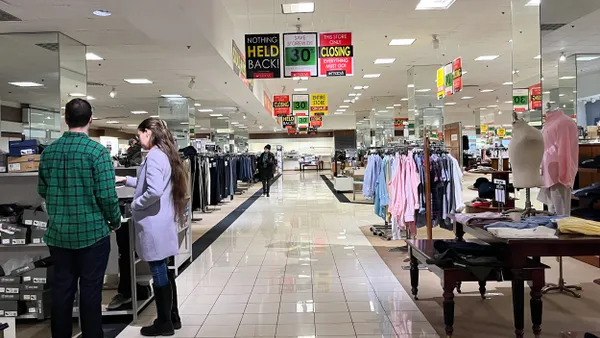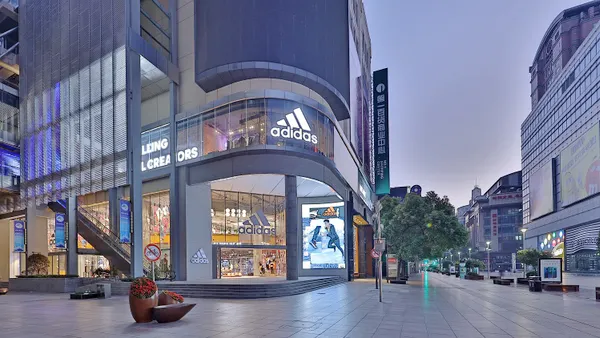If there's a silver lining to the pandemic for retailers, it's that within the span of a few months the industry's biggest players advanced their digital agenda the equivalent of several years. Not since Amazon's arrival two decades ago had the industry seen such a flurry of change. In a matter of weeks, retailers pivoted to meet the surge in online demand and set up new capabilities to deliver services like curbside pickup at scale.
Now the industry faces another one-two challenge: Redoubling its online efforts to sustain the digital momentum while prepping for the experiential in-store shopping that will attract consumers back inside when a vaccine becomes available. It's this dual mandate that will position retailers for success in the post-vaccine era.
During the pandemic, category-leading brick and mortar retailers have grabbed huge gains in e-commerce market share. Second quarter earnings showed triple-digit growth in online sales at Walmart (97%), Target (195%) and Kroger (127%) as well as Home Depot (100%) and Best Buy (242%) and niche retailers like Tractor Supply – far outstripping Amazon's "just" 40% year-on-year growth. Amazon lost share in e-commerce to category-leading physical retailers.
Leading physical retailers' digital businesses have advanced five to 10 years with this structural shift, and the change isn't transitory. More than 70% of US consumers say they intend to stick with the new shopping behaviors they adopted during the pandemic, according to a survey by McKinsey.
Through the forced reshaping of consumer behavior, the pandemic has enabled an irreversible convergence of physical and digital channels at scale. Significant uptake in options such as curbside pickup, buy online pick up in store (BOPIS) and buy online ship to store (BOSS) have brought the channels together in a meaningful way. At Target, for example, curbside pickup was up more than 700% and same-day services grew 273% overall in Q2 year over year.
Readying for the Post-Vaccine Era
As the world awaits a vaccine, retailers face a dual mandate. For now, consumer dwell time remains skewed towards digital channels. Product availability, value and convenience will continue to be the key drivers.
When the post-vaccine era arrives, however, experiential retail will take center stage as dwell time shifts to a healthy mix of digital and in-store sales. Once shoppers return to stores, ensuring a wow factor will encourage them to stay.
Here are the strategic steps that will help retailers meet the new dual mandate for success:
- Double down on private label efforts. COVID-19 has shifted consumer demand to big brands and private labels. As the direct-to-consumer (DTC) channel gained traction among stay-at-home consumers, Nike and other category-leading brands experienced massive lifts in Q2 sales. This change could lead to a short-term supply squeeze for retailers as brands allocate more merchandise to their own channels. Making private labels a priority is key for retailers to ensure availability of products through peak demand periods. Private labels' more affordable price points also help deliver on consumers' value expectation. In the long run, a compelling private label strategy like Costco's Kirkland can deliver more profitability and enhance customer loyalty. Similarly, Kohl's announcement of a private-label athleisure brand to advance its agenda in the active and casual apparel segment shows the retailer is doubling down on private labels.
- Get creative in offering value and convenience. Staying on consumers' radar means extending the value equation on an ongoing basis. Macy's is leading the way with a slew of new options. Its partnership with Klarna puts a digital spin on layaway by letting online shoppers pay for purchases in installments. After launching curbside pickup, it readied for the holiday season by introducing same-day delivery in partnership with DoorDash. In the convenience sector, 7-Eleven is redefining how customers shop for food and snacks. In April, when much of the U.S. was in lockdown, the chain offered free contactless delivery with its 7Now delivery app.
- Rethink how stores are used. Best Buy is testing a ship-from-store hub model that turns a quarter of its nearly 1,000 stores into fulfillment hubs. The chain is betting the hub model will speed orders and improve efficiency. Walmart is converting four stores into laboratories that test ways to better combine physical and digital and also improve customer experience. Given Amazon and Alibaba's announced plans to open thousands of stores across formats, the converged channel has evolved into a long-term phenomenon that's here to stay. For category-leading retailers, it also means rethinking the optimal store count, format and locations in the hyperconverged, post-pandemic phygital world.
- Reimagine the in-store experience. As in-store dwell times increase in the post-vaccine era, consumers' expectations will be different: They'll expect the same frictionless, curated, immersive and personalized experience that digital channels offer. Luxury shoemaker Salvatore Ferragamo is leveraging the power of mixed reality to allow consumers to choose and customize its shoe collection either in store or online. While retailers obsess about customer experience across channels, not many invest adequately in the store associate experience. Armed with digital solutions and insights for guided selling, store associates can be key enablers for experiential retail.
- Transform merchandising. Like real estate, merchandising is the bedrock of retail. To achieve true omnichannel capabilities, however, merchandising needs to operate as an integrated function across channels, and merchants, much like store associates, need to be quickly enabled with tools and insights. It's a change we're already seeing underway. After decades of siloed operations, Walmart announced earlier this year that it's merging stores and online buying teams. While retailers have invested aggressively in building customer intelligence capabilities, most have under-invested in product intelligence. Because consumers will be looking for personalized cross-channel experiences as digital penetration remains high, analytics and AI-powered product intelligence will be a key differentiator in the modernization of merchandising.
Long-term Retail winners will be those that embrace the dual mandate and invest in building or acquiring capabilities to deliver experiential retail when consumers return to malls and stores post vaccine. Retailers may also need to rethink their partner ecosystem to successfully execute on this dual mandate.
For more, visit the Retail sections of our website, or contact us.










